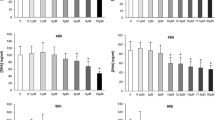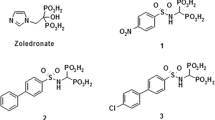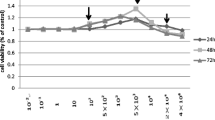Abstract
Recent studies have reported oxidative damage due to bisphosphonate (BP) in various cancer tissues and neurons, although basic fibroblast growth factor (bFGF) induced antioxidant effects in the cells. The bFGF may modulate the BP-induced oxidative stress in oral epithelium of rats. This study was undertaken to explore possible beneficial antioxidant effects of bFGF on oxidative stress induced by BP in oral epithelium of rats. Twenty-eight rats were equally divided into four groups. The first group was used as control. The second, third and fourth groups intraperitoneally received BP (zoledronic acid), bFGF and BP + bFGF. At the end of 10 weeks, the rats were sacrificed, and oral epithelium samples were taken for analyses. In BP group, the lipid peroxidation levels were increased in the oral epithelium, while the activities of glutathione peroxidase (GSH-Px) and the concentrations of total antioxidant status (TAS) were decreased. In rats treated with bFGF, lipid peroxidation levels decreased, and the activities of GSH-Px and concentrations of TAS improved in the oral epithelium. However, zinc and copper levels were decreased in the oral epithelium by BP and bFGF treatments. Concentrations of vitamin E and reduced glutathione in the samples did not change in the groups. In conclusion, treatment with bFGF modulated the antioxidant redox system and reduced the oral epithelium oxidative stress induced by BP. However, zinc and copper levels were decreased by BP and bFGF treatments.


Similar content being viewed by others
Abbreviations
- bFGF:
-
Basic fibroblast growth factor
- BP:
-
Bisphosphonate
- Cu:
-
Copper
- GSH:
-
Glutathione
- GSH-Px:
-
Glutathione peroxidase
- MDA:
-
Malondialdehyde
- ROS:
-
Reactive oxygen species
- SOD:
-
Superoxide dismutase
- TAS:
-
Total antioxidant status
- Zn:
-
Zinc
References
Coscia M, Quaglino E, Iezzi M et al (2010) Zoledronic acid repolarizes tumour-associated macrophages and inhibits mammary carcinogenesis by targeting the mevalonate pathway. J Cell Mol Med 14:2803–2815
Kuroshima S, Go VA, Yamashita J (2012) Increased numbers of nonattached osteoclasts after long-term zoledronic acid therapy in mice. Endocrinology 153:17–28
Ravosa MJ, Ning J, Liu Y, Stack MS (2011) Bisphosphonate effects on the behaviour of oral epithelial cells and oral fibroblasts. Arch Oral Biol 56(5):491–498
Ohnuki H, Izumi K, Terada M et al (2012) Zoledronic acid induces S-phase arrest via a DNA damage response in normal human oral keratinocytes. Arch Oral Biol 57:906–917
Demasi M, Laurindo FR (2012) Physiological and pathological role of the ubiquitin-proteasome system in the vascular smooth muscle cell. Cardiovasc Res 95:183–193
Chen CH, Henry PD (1997) Atherosclerosis as a microvascular disease: impaired angiogenesis mediated by suppressed basic fibroblast growth factor expression. Proc Assoc Am Physicians 109:351–361
Guo Q, Sebastian L, Sopher BL et al (1999) Neurotrophic factors [activity-dependent neurotrophic factor (ADNF) and basic fibroblast growth factor (bFGF)] interrupt excitotoxic neurodegenerative cascades promoted by a PS1 mutation. Proc Natl Acad Sci U S A 96:4125–4130
Jo M, Nishikawa T, Nakajima T et al (2011) Oxidative stress is closely associated with tumor angiogenesis of hepatocellular carcinoma. J Gastroenterol 46:809–821
Barut A, Barut F, Kandemir NO et al (2012) Placental chorangiosis: the association with oxidative stress and angiogenesis. Gynecol Obstet Invest 73:141–151
Tenta R, Pitulis N, Tiblalexi D et al (2008) Mechanisms of the action of zoledronic acid on human MG-63 osteosarcoma cells. Horm Metab Res 40:737–745
Yang DM, Chi CW, Chang HM et al (2004) Effects of clodronate on cancer growth and Ca2+ signaling of human thyroid carcinoma cell lines. Anticancer Res 24:1617–1623
Nazıroğlu M (2009) Role of selenium on calcium signaling and oxidative stress-induced molecular pathways in epilepsy. Neurochem Res 34:2181–2191
Özgül C, Nazıroğlu M (2012) TRPM2 channel protective properties of N-acetylcysteine on cytosolic glutathione depletion dependent oxidative stress and Ca2+ influx in rat dorsal root ganglion. Physiol Behav 106:122–128
Choi J, Opalenik SR, Wu W, Thompson JA, Forman HJ (2000) Modulation of glutathione synthetic enzymes by acidic fibroblast growth factor. Arch Biochem Biophys 375:201–209
Amagase K, Inaba A, Senta T, Ishikawa Y, Nukui K, Murakami T, Takeuchi K (2011) Gastric ulcerogenic and healing impairment effects of risedronate, a nitrogen-containing bisphosphonate in rats. Comparison with alendronate and minodronate. J Physiol Pharmacol 62:609–618
Ozcelik D, Uzun H, Nazıroglu M (2012) N-acetylcysteine attenuates copper overload-induced oxidative injury in brain of rat. Biol Trace Elem Res 147:292–298
Ozcelik D, Nazıroglu M, Tunçdemir M, Celik O, Oztürk M, Flores-Arce MF (2012) Zinc supplementation attenuates metallothionein and oxidative stress changes in kidney of streptozotocin-induced diabetic rats. Biol Trace Elem Res 150:342–349
Placer ZA, Cushman L, Johnson BC (1966) Estimation of products of lipid peroxidation (malonyl dialdehyde) in biological fluids. Anal Biochem 16:359–364
Lowry OH, Rosenbrough NJ, Farr AL, Randall RJ (1951) Protein measurement with the Folin phenol reagent. J Biol Chem 193:265–275
Desai ID (1984) Vitamin E analysis methods for animal tissues. Methods Enzymol 105:138–147
Nazıroğlu M, Çay M (2008) Vitamin C modulates blood lipid peroxidation and antioxidant enzyme values in rats exposed to cigarette smoke. Cell Membr Free Radic Res 1:73–77
Sedlak J, Lindsay RHC (1968) Estimation of total, protein bound and non-protein sulfhydryl groups in tissue with Ellman’s reagent. Anal Biochem 25:192–205
Lawrence RA, Burk RF (1976) Glutathione peroxidase activity in selenium-deficient rat liver. Biochem Biophys Res Commun 71:952–958
Erel O (2004) A novel automated direct measurement method for total antioxidant capacity using a new generation, more stable ABTS radical cation. Clin Biochem 37:277–285
Nazıroğlu M (2007) New molecular mechanisms on the activation of TRPM2 channels by oxidative stress and ADP-ribose. Neurochem Res 32:1990–2001
Espino J, Bejarano I, Paredes SD, Barriga C, Rodríguez AB, Pariente JA (2011) Protective effect of melatonin against human leukocyte apoptosis induced by intracellular calcium overload: relation with its antioxidant actions. J Pineal Res 51:195–206
Espino J, Bejarano I, Paredes SD et al (2010) Melatonin counteracts alterations in oxidative metabolism and cell viability induced by intracellular calcium overload in human leucocytes: changes with age. Basic Clin Pharmacol Toxicol 107:590–597
Collazo D, Takahashi H, McKay RD (1992) Cellular targets and trophic functions of neurotrophin-3 in the developing rat hippocampus. Neuron 9:643–656
Karabulut AB, Gül M, Karabulut E, Kiran TR, Ocak SG, Otlu O (2010) Oxidant and antioxidant activity in rabbit livers treated with zoledronic acid. Transplant Proc 42:3820–3822
Nazıroğlu M (2011) TRPM2 cation channels, oxidative stress and neurological diseases: where are we now? Neurochem Res 36:355–366
Şener G, Kapucu C, Cetinel S, Cikler E, Ayanoğlu-Dülger G (2005) Gastroprotective effect of leukotriene receptor blocker montelukast in alendronat-induced lesions of the rat gastric mucosa. Prostaglandins Leukot Essent Fatty Acids 72:1–11
Sato T, Wilson TS, Hughes LF, Konrad HR, Nakayama M, Helfert RH (2011) Age-related changes in levels of tyrosine kinase B receptor and fibroblast growth factor receptor 2 in the rat inferior colliculus: implications for neural senescence. Neuroscience 103:695–702
Takeuchi K, Amagase K (2012) Evaluation of gastric ulcerogenic and healing impairment effects of bisphosphonates: adverse gastric reactions of bisphosphonate. Curr Protoc Toxicol 21:1–29
Nazıroğlu M (2012) Molecular role of catalase on oxidative stress-induced Ca(2+) signaling and TRP cation channel activation in nervous system. J Recept Signal Transduct Res 32:134–141
Eide DJ (2011) The oxidative stress of zinc deficiency. Metallomics 3:1124–1149
Zinnuroglu M, Dincel AS, Kosova F, Sepici V, Karatas GK (2012) Prospective evaluation of free radicals and antioxidant activity following 6-month risedronate treatment in patients with postmenopausal osteoporosis. Rheumatol Int 32:875–880
Conflict of Interest
There is no conflict interest and financial support in the current study.
Author information
Authors and Affiliations
Corresponding author
Rights and permissions
About this article
Cite this article
Koçer, G., Nazıroğlu, M., Çelik, Ö. et al. Basic Fibroblast Growth Factor Attenuates Bisphosphonate-Induced Oxidative Injury but Decreases Zinc and Copper Levels in Oral Epithelium of Rat. Biol Trace Elem Res 153, 251–256 (2013). https://doi.org/10.1007/s12011-013-9659-y
Received:
Accepted:
Published:
Issue Date:
DOI: https://doi.org/10.1007/s12011-013-9659-y




